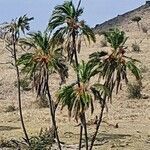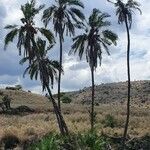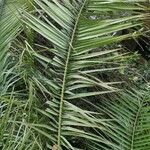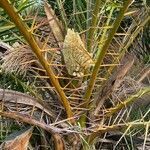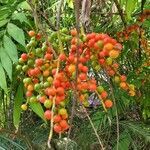Clustering, very rarely solitary palm, often forming dense thickets with trunks ultimately to 10 m. or more tall, ± 15 cm. diameter, occasionally flowering while still acaulescent.. Trunk dull brown, free of leaf-sheaths below, with persistent leaf-sheaths above, in uppermost 1–2 m. irregularly marked with oblique leaf-scars, and bearing persistent leaf-bases; injured stem exuding a clear yellowish gum.. Crown of ± 25 green leaves or more, dead leaves frequently rather long-persistent. Leaf to 2.5 m. long, bright shiny green, not glaucous, arcuate; true petiole ± 15 cm., with coarse red-brown sacking-like sheath; apparent petiole ± 50 cm. long by 2.5 cm. wide, armed with fanned irregularly arranged acanthophylls to 6 cm. long by 4 mm. wide; leaflets ± 120 on each side of the rachis, arranged very stiffly and regularly above, grouped below in 2’s–4’s, fanned, to 25 cm. long by 2 cm. wide, pointed, occasionally sharply so, when old splitting along the main vein, when young bearing caducous white indumentum on the lower surface.. Inflorescences with prophyll 20–50 cm. long by 7–10 cm. wide, often long persisting, frequently splitting longitudinally into 2 halves, bright orangey brown at anthesis, fading to dull grey-brown, covered with flocculent caducous grey-brown indumentum when young.. Peduncle of ♂ inflorescence not greatly elongating, sometimes scarcely emerging from the bract, 10–30 cm. long by ± 1.5 cm. wide, greatly compressed; rachillae 40–70 in number, arranged in groups and partial spirals, to 15 cm. long, usually much less, 2.5 mm. in diameter near the base, tapering to 1.5 mm. distally.. Male flowers creamy white, rapidly turning brown, musty scented; calyx ± 1 mm. high; petals ± 6–7 mm. long, acute, fleshy, somewhat dentate towards the tip, the tip slightly reflexed at anthesis; stamens 6, slightly shorter than the petals, pale brown.. Female inflorescence emerging from the bract and often greatly elongating after anthesis, with the fruiting rachillae pendulous; rachillae ± 40–60, 15–40 cm. long, bearing up to 40 greenish flowers, singly or in small groups.. Female flowers greenish, rounded, ± 2 mm. in diameter; calyx ± 1.5 mm. high; petals rounded ± 2 mm. by 2 mm.; carpels 3, ± 2 mm. high, the stigmas reflexed, just emerging from the tightly imbricating petals.. Fruit almost always developed from 1 carpel only, very rarely all 3 developing; calyx in fruit to 2 mm. high; petals in fruit to 5 mm. high by 8 mm. wide; fruit 1.3–1.7 cm. long by 0.9–1.3 cm. wide, varying from pale yellow to orange or dull red; epicarp smooth; mesocarp 1–2 mm. thick, dry or moist and sweet.. Seed 1–1.2 cm. long by 0.6–0.8 cm. wide, deeply grooved along one side; embryo lateral.. Fig.1.
More
A palm. It can be a stemless suckering bush or have a ring of suckers around the base. It often grows 3-6 m high but can be 10-25 m high. It can also be a many stemmed clump. The old stems hang over then curve upwards near the end. The trunk can be 30 cm across. The leaves are long and hang over. They are feather-shaped and 3-4 m long. There are up to 50 leaflets on each side of the leaf stalk and these are narrow and pointed. The lowermost leaflets are reduced to spines. The flowers are of separate sexes on separate trees. The male and female flowers are borne in long bunches. They are small and cream coloured. The male flowers are cup-shaped and the female flowers are round. The female flowers produce yellow fruit. The fruit are oval and 1-1.5 cm long. The flesh is edible when ripe.
Perennial tree or shrub, 3-6(10) m high, often several stems. Leaves pinnate, 2-4 m long, lanceolate or ensiform, reduced to spines at base. Flowers regularly spaced, dioecious Male flowers: calyx cupular; petals 3; stamens 6, filaments connate at base. Female flowers: calyx as in male; petals short, truncate; staminodes 6. Flowering time Aug.-Oct. Fruit a fleshy, ovoid, edible berry.
Tree, up to 10 m high. Leaves pinnate or feather-shaped, 3-4 m long, lowermost leaflets reduced to spines. Fruits oval, 10-15 mm long, bright orange when mature. Flowers brown.
Stems multiple, usually ascending, to 8 m, diam. 10--15 cm. Fruits ripening from green through orange to reddish brown, ellipsoid, length 12--18 mm, diam. 7--8 mm. 2n = 36.
A tufted palm, often forming clumps, the stems occasionally as tall as 28 ft. but commonly much less
